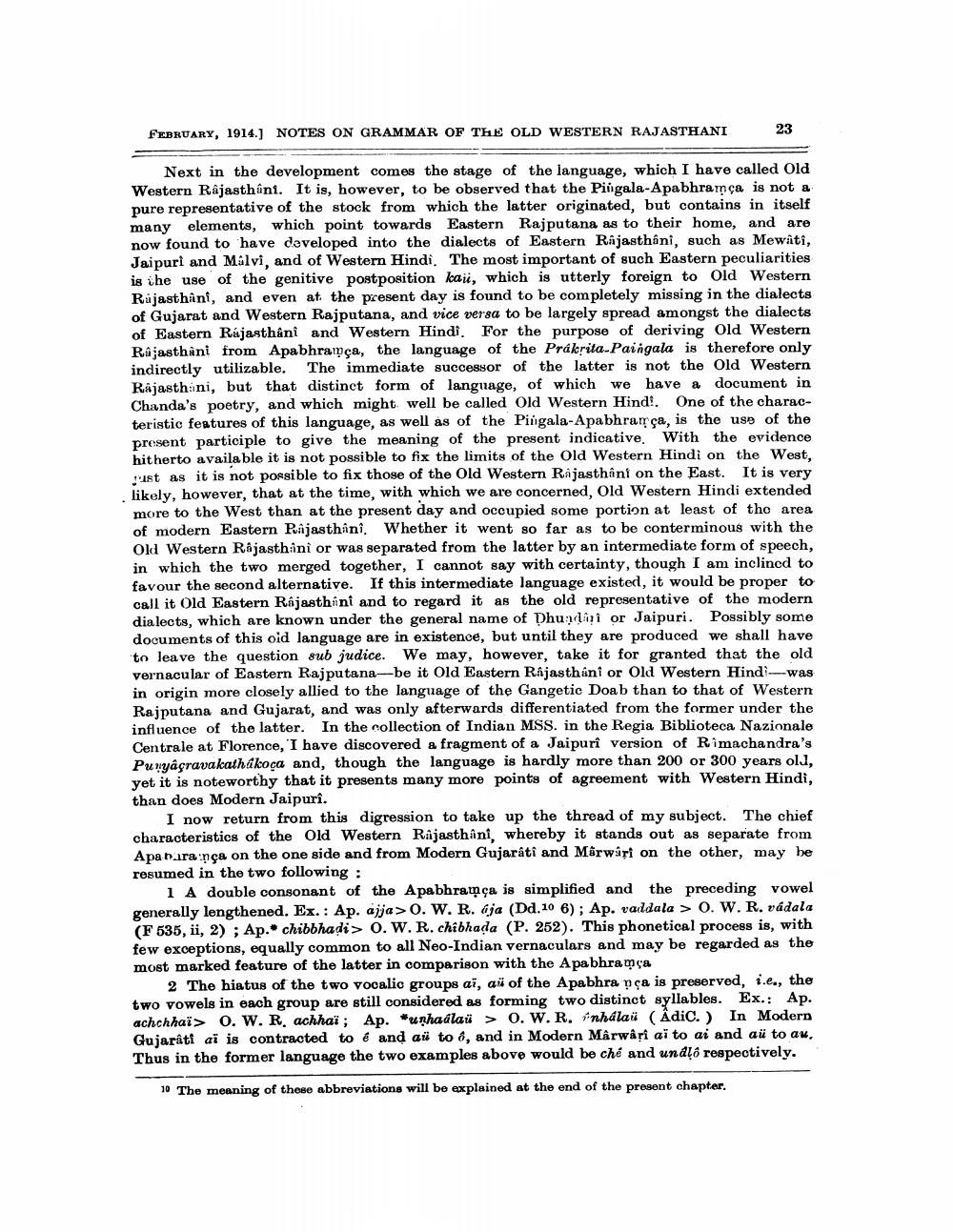________________
FEBRUARY, 1914.) NOTES ON GRAMMAR OF THE OLD WESTERN RAJASTHANI
23
Next in the development comes the stage of the language, which I have called Old Western Rajasthini. It is, however, to be observed that the Pingala-Apabhramça is not a pure representative of the stock from which the latter originated, but contains in itself many elements, which point towards Eastern Rajputana as to their home, and are now found to have developed into the dialects of Eastern Rajasthani, such as Mewati, Jaipuri and Milvi, and of Western Hindi. The most important of such Eastern peculiarities is ühe use of the genitive postposition kaü, which is utterly foreign to Old Western Rajasthani, and even at the present day is found to be completely missing in the dialects of Gujarat and Western Rajputana, and vice versa to be largely spread amongst the dialects of Eastern Rájasthani and Western Hindi. For the purpose of deriving Old Western Rajasthini from Apabhraça, the language of the Prakrita-Paingala is therefore only indirectly utilizable. The immediate successor of the latter is not the Old Western Rajasthini, but that distinct form of language, of which we have a document in Chanda's poetry, and which might well be called Old Western Hind!. One of the characteristic features of this language, as well as of the Pingala-Apabhraça, is the use of the present participle to give the meaning of the present indicative. With the evidence hitherto available it is not possible to fix the limits of the Old Western Hindi on the West, fost as it is not possible to fix those of the Old Western Rajasthani on the East. It is very likely, however, that at the time, with which we are concerned, Old Western Hindi extended more to the West than at the present day and occupied some portion at least of the area of modern Eastern Pajasthani. Whether it went so far as to be conterminous with the Old Western Rajasthani or was separated from the latter by an intermediate form of speech, in which the two merged together, I cannot say with certainty, though I am inclined to favour the second alternative. If this intermediate language existed, it would be proper to call it Old Eastern Rajasthini and to regard it as the old representative of the modern dialects, which are known under the general name of Dhudari or Jaipuri. Possibly some documents of this oid language are in existence, but until they are produced we shall have to leave the question sub judice. We may, however, take it for granted that the old vernacular of Eastern Rajputana--be it Old Eastern Rajasthani or Old Western Hindi-was in origin more closely allied to the language of the Gangetic Doab than to that of Western Rajputana and Gujarat, and was only afterwards differentiated from the former under the influence of the latter. In the collection of Indian MSS. in the Regia Biblioteca Nazionale Centrale at Florence, I have discovered a fragment of a Jaipurî version of Rimachandra's Punyagravakathakoça and, though the language is hardly more than 200 or 300 years old, yet it is noteworthy that it presents many more points of agreement with Western Hindi, than does Modern Jaipuri.
I now return from this digression to take up the thread of my subject. The chief characteristics of the Old Western Rajasthani, whereby it stands out as separate from Apa brança on the one side and from Modern Gujarati and Mirwari on the other, may be resumed in the two following:
1 A double consonant of the Apabhramça is simplified and the preceding vowel generally lengthened. Ex.: Ap. ajja>0. W. R. 6ja (Dd. 10 6); Ap. vaddala > 0. W. R. vádala (F 535, ii, 2); Ap.. chibbhadi > 0. W. R. chibhada (P. 252). This phonetical process is, with few exceptions, equally common to all Neo-Indian vernaculars and may be regarded as the most marked feature of the latter in comparison with the Apabhramça
2 The hiatus of the two vocalic groups ai, ai of the Apabhrapça is preserved, i.e., the two vowels in each group are still considered as forming two distinct syllables. Ex.: Ap. achchhaï> 0. W. R. achhaï; Ap. *unhaálaü > 0. W. R. Anhalaü (Adic. ) In Modern Gujarati ai is contracted to é and ai to 8, and in Modern Mârwâri ai to ai and aü to au. Thus in the former language the two examples above would be ché and undļo respectively.
10 The meaning of these abbreviations will be explained at the end of the present chapter.




